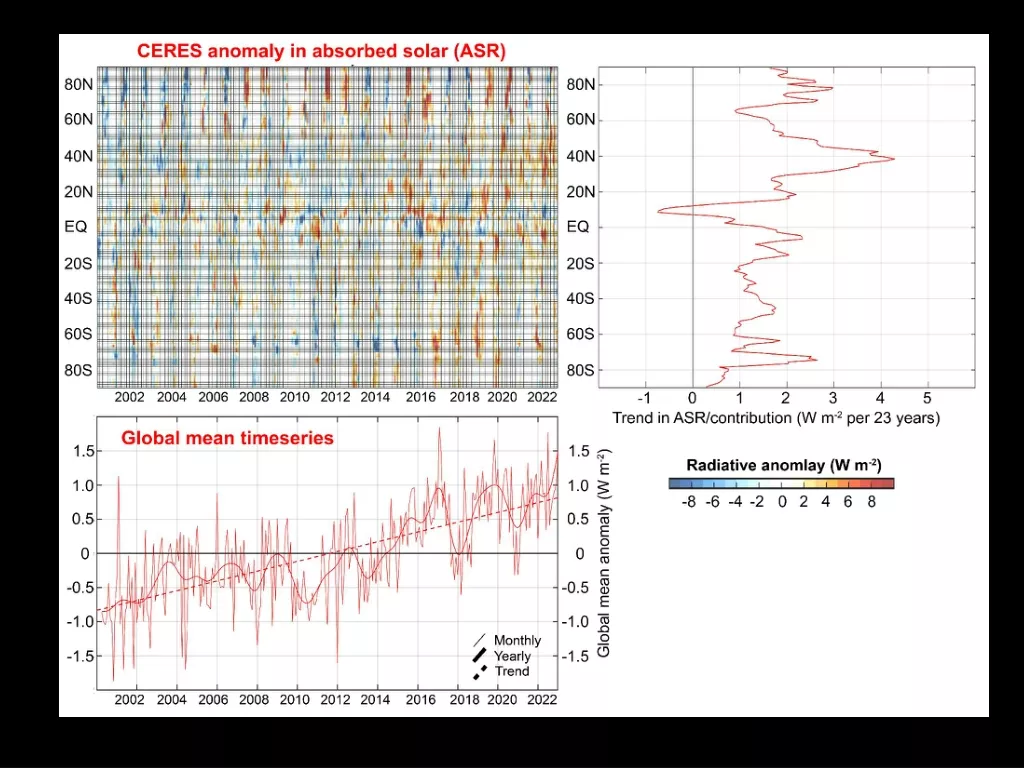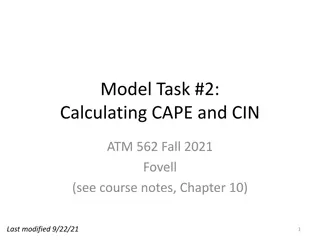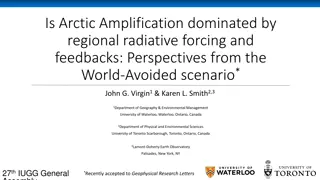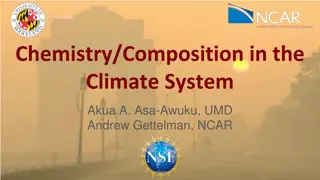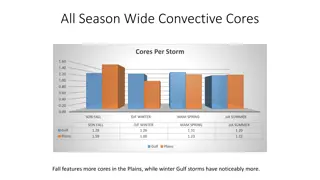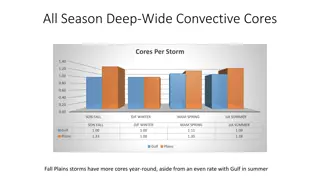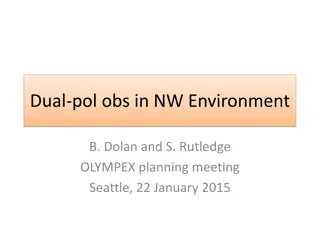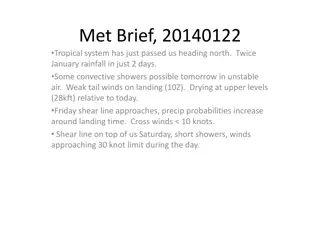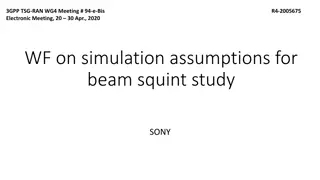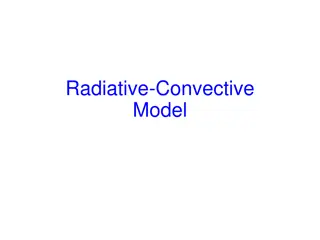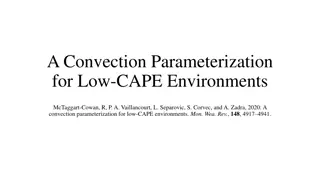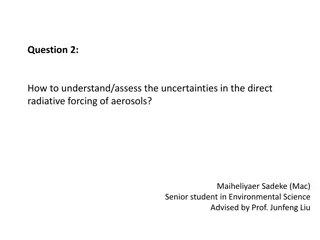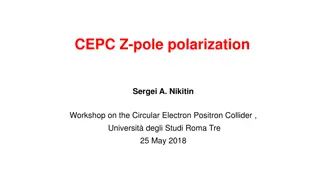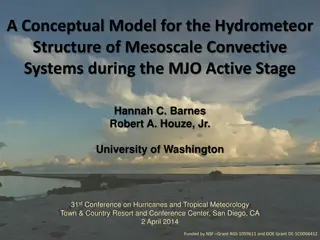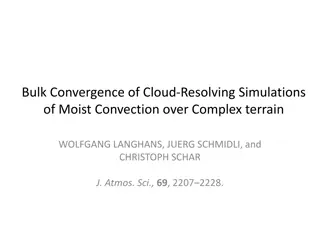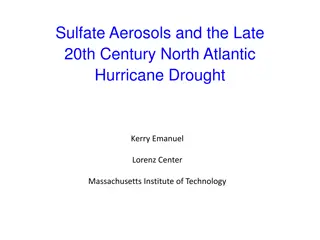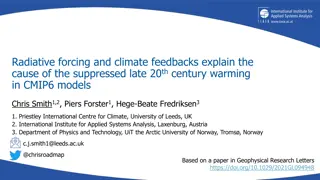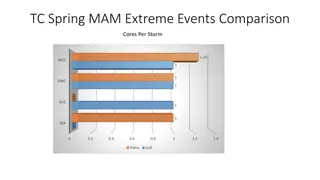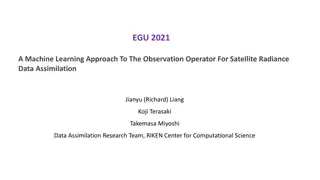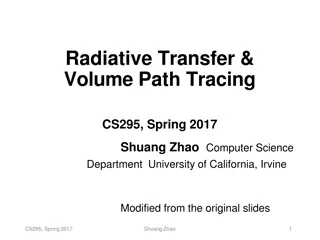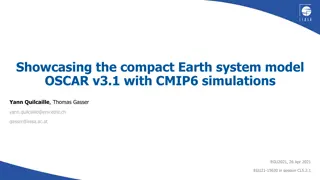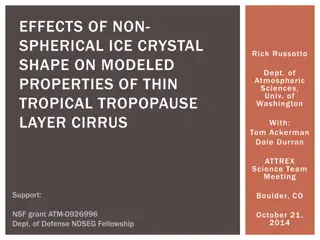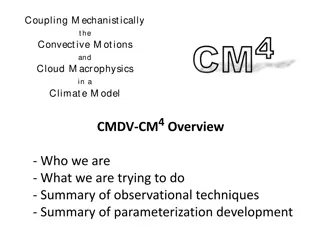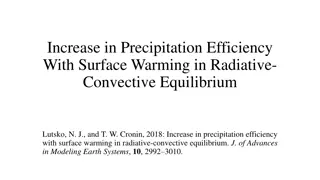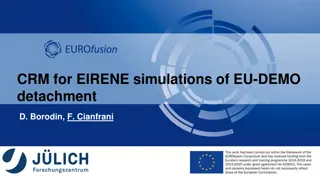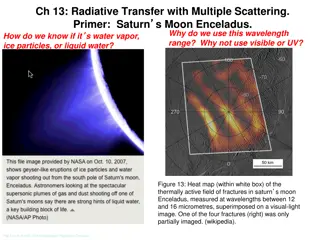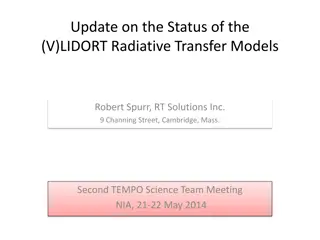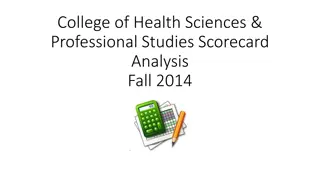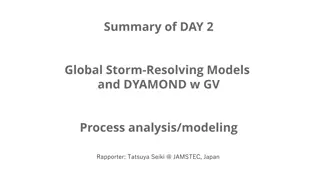Observed Changes in Atmospheric Solar Reflection and Surface Albedo
Exploring the attribution of changes in Earth's Albedo Shortwave Radiation (ASR) to various processes including atmospheric and surface contributions. The impacts of incident solar radiation, cloud reflection, absorption, and surface albedo are analyzed, along with the radiative sensitivity from iso
0 views • 12 slides
Advancements in Solar-Terrestrial Research and Meteorology
The Solar-Terrestrial Centre of Excellence (STCE) focuses on ongoing activities and opportunities in the field of meteorology, with a special emphasis on Antarctica. Their annual meetings cover topics like water vapor feedback mechanisms, extreme weather events forecasting, cloud and precipitation s
0 views • 14 slides
CAPE and CIN Calculation in Atmospheric Modeling
Learn how to calculate Convective Available Potential Energy (CAPE) and Convective Inhibition (CIN) using the Weisman-Klemp sounding method. The procedure involves defining parcel properties, lifting the parcel level by level, and performing saturation adjustments. Explore the concepts of positive a
4 views • 14 slides
Regional Radiative Forcing and Feedbacks in Arctic Amplification
Arctic Amplification (AA) is explored in the context of regional radiative forcing and feedbacks in the study by Virgin and Smith (2019). The research investigates the dominance of these factors in the meridional variations of AA, highlighting the contributions of different feedback mechanisms durin
1 views • 22 slides
Chemistry and Composition in the Climate System
Dive into the intricate relationship between chemistry and composition in the climate system, exploring topics such as radiative effects, stratosphere-troposphere coupling, aerosol-cloud interactions, and the impact of various gases and particulates on radiative forcing. Discover how changes in comp
0 views • 25 slides
Radiative Forcings in Climate Dynamics
Climate forcings directly impact global temperature by changing solar energy absorption and greenhouse gas concentrations. Shortwave forcings involve changes in solar radiation absorbed, while longwave forcings relate to greenhouse gases affecting the greenhouse effect. Positive radiative forcings l
2 views • 36 slides
Comparison of Convective Cores in Gulf and Plains Regions
A detailed comparison of convective cores between Gulf and Plains regions across different seasons reveals interesting patterns. Gulf storms have more cores in the fall, with larger sizes and more cores in winter. The Plains see more cores in the spring season and have generally bigger storms year-r
1 views • 4 slides
Analysis of Seasonal Variations in Gulf Plains Convective Cores
The analysis reveals fascinating insights into Gulf Plains convective cores, showcasing variations in core numbers, average pixels per storm, pixels per core, and core sizes across different seasons. Deep-Wide cores dominate in the summer, while Gulf cores are larger in the fall. The study sheds lig
1 views • 4 slides
Dual-Pol Observations in NW Environment OLYMPEX Planning Meeting
The OLYMPEX planning meeting in Seattle on January 22, 2015 discussed the contribution of polarimetric S-band radar in rain estimation systems targeted by OLYMPEX. The use of specific differential phase (Kdp) helps in minimizing assumptions about drop size distribution, convective/stratiform distinc
1 views • 15 slides
Unstable Weather Alert: Tropical System Impact and Shear Line Approaching
Tropical system passing north, bringing heavy rainfall and unstable air. Expect convective showers, tailwinds on landing, and shifting precipitation patterns. Concerns about tropical showers, moisture levels, and shear line impact on landing and takeoff conditions. Images of weather situations provi
2 views • 10 slides
Simulation Assumptions and Performance Degradation Study on Beam Squint in 3GPP Meeting
Background on beam squint in conducted power of transmitted CCs causing radiative domain impairment and gain droop, with a problem statement on degradation of CC2 spherical coverage when CC1 and CC2 are separated by frequency. The study involves refined simulation assumptions to quantify radiative d
0 views • 7 slides
Detailed Overview of a Radiative-Convective Model for Weather Prediction
This detailed overview explores the components of a Radiative-Convective Model, covering convection, radiation transfer, cloud-radiation interaction, and surface fluxes. The model incorporates algorithms and parameterizations to simulate various cloud types, radiative transfer processes, and surface
1 views • 9 slides
Convection Parameterization for Low-CAPE Environments
Many global Numerical Weather Prediction systems face challenges predicting convective activity in low-CAPE environments. This study introduces a convection parameterization scheme based on moisture convergence to better represent convective effects. The scheme focuses on the triggering function, up
3 views • 38 slides
Uncertainties in Direct Radiative Forcing of Aerosols
The uncertainties in the direct radiative forcing of aerosols can be assessed by considering factors such as emissions, lifetime, Mass Absorption Cross Section (MAC), Aerosol Absorption Optical Depth (AAOD), and forcing efficiency. Variations in these factors contribute to the overall uncertainty in
0 views • 9 slides
Radiative Polarization Techniques in CEPC for Precision Measurements of Z-Pole Mass
Prof. Jie Gao led discussions on the CEPC polarization program, focusing on obtaining transverse and longitudinal polarizations. The use of special wigglers to enhance the polarizing effect of the magnetic field was highlighted, reducing the time needed for radiative self-polarization. Strategies to
1 views • 22 slides
Conceptual Model for Hydrometeor Structure of Mesoscale Convective Systems during MJO Active Stage
This study presented a conceptual model for characterizing the hydrometeor structure of Mesoscale Convective Systems (MCSs) during the Madden-Julian Oscillation (MJO) active stage. The research focused on the kinematic structure of MCSs and utilized radar data, compositing methodology, and convectiv
2 views • 24 slides
Analysis of Cloud-Resolving Simulations Over Complex Terrain
Examining cloud-resolving simulations of moist convection over complex terrain using large eddy simulation (LES) and deep convective fluxes. The study includes characteristics of the simulations, numerical convergence, and turbulent diffusion. Results reveal insights into the behavior of convective
0 views • 20 slides
Climate System Response to Perturbations: Insights from Hugues Goosse's Chapter 4
Hugues Goosse's Chapter 4 delves into the response of the climate system to perturbations, emphasizing radiative forcing, greenhouse gases, aerosols, and their impacts on Earth's radiative budget. The chapter intricately describes physical feedbacks, interactions involving energy balance, hydrologic
0 views • 40 slides
North Atlantic Hurricane Drought and Aerosol Impact
This study explores the influence of sulfate aerosols on the late 20th-century North Atlantic Hurricane drought, focusing on the interaction of European sulfate aerosols and African dust. It investigates the radiative forcing effects and variability in hurricane activity, proposing hypotheses relate
1 views • 17 slides
Suppressed Late 20th Century Warming in CMIP6 Models
Recent studies have explored the suppressed late 20th-century warming seen in CMIP6 models compared to CMIP5. The differences in warming patterns are attributed to strong aerosol forcing, with implications for radiative forcing and climate feedbacks. Estimating historical radiative forcing and exami
1 views • 7 slides
Extreme Weather Events Comparison in Different Seasons
This dataset contains detailed comparisons of extreme weather events in Spring, Summer, and Autumn for different types of convective cores and stratiform regions. The data includes information on average pixels per storm, cores per storm, and stratiform versus convective ratios across the Plains and
0 views • 30 slides
Machine Learning Approach for Satellite Radiance Data Assimilation
This research explores using machine learning as the observation operator for satellite radiance data assimilation, aiming to improve the efficiency of the process. By training the machine learning model with model output and observations, the study investigates reducing the need for a physically-ba
0 views • 14 slides
Radiative Transfer and Volume Path Tracing
Explore the mathematical model of radiative transfer for simulating light scattering in participating media and translucent materials through volume path tracing. Learn about subsurface scattering and how radiance changes along ray segments in participating media. Delve into the origins and applicat
2 views • 44 slides
Overview of V*LIDORT and Other Radiative Transfer Models by Robert Spurr
The presentation provides an update on the status of V*LIDORT and other radiative transfer models as discussed at the Third TEMPO Science Team Meeting. It covers the LIDORT family overview, upgrades to the codes, new releases for RT models, and accelerated RT developments using PCA. The V*LIDORT cod
1 views • 12 slides
Comprehensive Overview of OSCAR v3.1: A Compact Earth System Model with CMIP6 Simulations
Showcasing the compact Earth system model OSCAR v3.1 and its CMIP6 simulations. OSCAR is a reduced-form Earth system model calibrated to emulate complex models, focusing on radiative forcing, temperatures, precipitation, ocean heat content, aerosols, ozone, and more. Historical periods and scenarios
0 views • 15 slides
Effects of Non-Spherical Ice Crystal Shape on Modeled Properties of Thin Tropical Tropopause Layer Cirrus
This study explores the impact of non-spherical ice crystal shapes on the properties of cirrus clouds in the thin tropical tropopause layer. Incorporating realistic ice crystal shapes into models affects fall speed, growth rate, and radiative absorption, influencing the time evolution of clouds. The
0 views • 38 slides
Coupling of Convective Motions and Cloud Macrophysics in Climate Model CMDV-CM4
This project led by Lawrence Berkeley National Laboratory aims to mechanistically couple convective motions and cloud macrophysics in the CMDV-CM4 climate model. Through observational techniques and parameterization development, they seek to evaluate and enhance current cloud representations, develo
1 views • 16 slides
Increase in Precipitation Efficiency with Surface Warming
The study examines how surface warming affects precipitation efficiency in radiative-convective equilibrium. Various factors influencing precipitation efficiency, such as microphysical processes and climate sensitivity, are discussed. Model experiments are conducted to test the sensitivity of precip
0 views • 33 slides
Collisional-Radiative Models for Plasma Detachment Control in Tokamaks
Explore the application of Collisional-Radiative Models (CRM) in EIRENE simulations for plasma detachment control in tokamaks. Learn about detached plasma divertor, main reactions in transport, vibrational states in molecular species, and more through a detailed study of particle species, reaction t
0 views • 10 slides
Radiative Transfer in Saturn's Moon Enceladus
Exploring the detection and characterization of water vapor, ice particles, and liquid water on Saturn's moon Enceladus using radiative transfer techniques at specific wavelength ranges. The study involves analyzing a thermal map of fractures on the moon and explains the use of wavelengths between 1
0 views • 27 slides
Update on (V)LIDORT Radiative Transfer Models and Upgrades
The update discusses the (V)LIDORT radiative transfer models by Robert Spurr from RT Solutions Inc., highlighting features like pseudo-spherical approximation, Jacobians generation, and new releases. It covers upgrades to the codes, including thread-safe implementation and new capabilities like BRDF
0 views • 11 slides
Climate Change and Radiative Forcing
Investigate the impact of radiative forcing on climate change through comprehensive data compiled by the IPCC. Over 800 scientists worldwide have contributed to five reports spanning from 1990 to 2014. The findings shed light on the factors influencing Earth's radiation budget, with a particular foc
1 views • 9 slides
Climate Change Radiative Forcing
IPCC Review of data on radiative forcing, the impact of factors on Earth's radiation budget, and the role of greenhouse gases in global warming. Reports by over 800 scientists from nearly 40 countries, highlighting the effects of atmospheric constituents, land-use changes, and human emissions on cli
0 views • 48 slides
Non-Perturbative Effects on Heavy Quark Radiative Energy Loss
This study delves into non-perturbative effects impacting the radiative energy loss of heavy quarks, exploring their implications in strongly coupled QGP and high-energy parton interactions. The research presents a T-matrix approach for energy loss and investigates various scenarios with different n
0 views • 25 slides
All Season Extreme Events Comparison
This data compares extreme weather events across all seasons, showcasing different core types per storm and their characteristics. The comparison includes broad stratiform events, deep convective cores, deep wide convective cores, and wide convective cores, highlighting differences in pixels per sto
0 views • 40 slides
Simulation of Cloud-Aerosol Lidar with Orthogonal Polarization (CALIOP) using GLOMAP
The study focuses on validating models by comparing them with CALIOP data, aiming to improve predictions on aerosol properties and radiative effects. The research involves investigating aerosol production modules and radiation impacts, utilizing CALIOP's extensive aerosol dataset. Alternative approa
1 views • 15 slides
Global Storm-Resolving Models and DYAMOND with GV Process Analysis
Explore the latest advancements in storm-resolving models and process analysis with a focus on vertical motion, aerosols, convective strength, cloud microphysics, and more. Key topics include thermal plumes, convective organization, and impactful weather phenomena such as tropical cyclones and polar
0 views • 5 slides
Mechanistic Coupling of Convective Motions and Cloud Macrophysics
Explore the integration of convective motions and cloud macrophysics in the CMDV-CM4 climate model through observational techniques and parameterization development at Lawrence Berkeley National Laboratory. This project aims to improve the representation of shallow clouds, evaluate current models, a
0 views • 16 slides
Robust Increase in CO2 Effective Radiative Forcing and Climate Dependency
Researchers present findings on the robust increase in CO2 effective radiative forcing in warmer climates, highlighting the impact of state dependencies on climate models. Experiments show significant increases in ERF, with implications for understanding climate change dynamics.
0 views • 8 slides
Weather Convection Schemes and Observation Basis
Understand the various convection schemes used in weather forecasting, such as Manabe et al. (1965) and Arakawa and Schubert (1974). Explore concepts like critical relative humidity and moisture supply methods. Learn about observational bases for cumulus clouds and the initiation of convective proce
0 views • 34 slides
